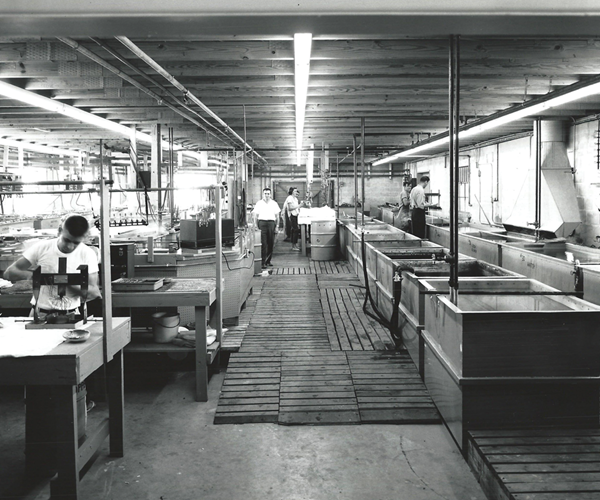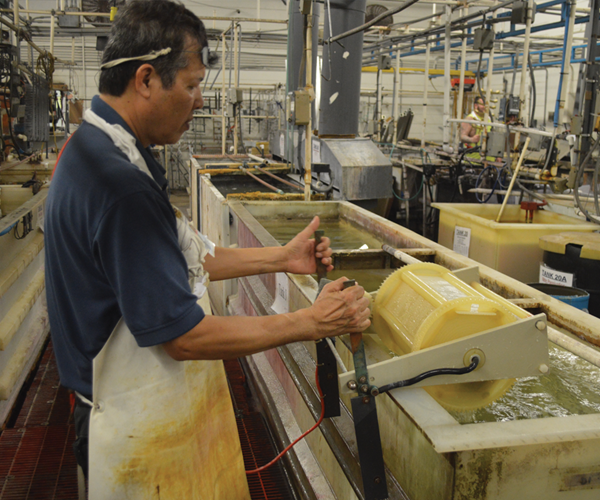Aerospace Finishing’s Race to the Moon
In our 80th year, a look back at how finishing helped NASA-led space projects.
#aerospace
Featured Content

During the space exploration period, Dixie Plating was recognized by Boeing as being a critical supplier.
At the time, Dixie Plating was recognized by Boeing as being a critical supplier, and I heard first-hand accounts from my uncle, also named Charles Eidschun, on how crazy a time it was in the plating industry.
When researching the connection between aerospace and finishing, I realized my family’s move to Florida was a result of many big aerospace companies moving there, too. This led me to look back at the last 50-plus years of aerospace finishing, and the impact it has had on the industry, and certainly on our family-owned plating operation.
A number of finishing innovations were necessary to go to the moon and conquer the challenges of space flight. New products and processes overcame radiation, corrosion and extreme environmental conditions, all made possible by the finishing industry.
There are still challenges; the same issues seen in space decades ago are ones we are seeing today. Improved testing practices are helping to overcome these challenges and support future missions. The Materials International Space Station Experiment (MISSE) testing program—which is taking coatings into space and seeing how they hold up—will help us in the next step of exploration.
Florida and Space Exploration
My uncle Charles has some great memories of what Florida was like in the initial phases of the space race, and what it is today. There was a lot at stake.
While there is always a rush to get parts plated and to the supplier, Charles said they would plate parts that would have to go out the next day for a rocket launch test for the Space Shuttle, or else they could not launch.
Our initial work was for Boeing, Honeywell and Sperry Microwave, which involved gold plating for electronics, and one of the best stories was hearing that Boeing would mail a check with the job, wanting their parts done immediately. They were willing to add pressure by sending the check so we would run their parts first, no matter what. It worked. We spent many countless days and nights running parts so that we would have them completed for pickup the next morning.
Most of the plating our company performed for NASA was gold, silver and rhodium plating. Over time, we generated changes that we would never have thought of had we not moved to Florida and gotten involved in that industry. It changed everything for our family business.
Aerospace Plating Innovations
From the humid, corrosion-friendly atmosphere of Kennedy Space Center, to the extreme heat of ascent, or even to the cold vacuum of space, the space program faces one hostile environment after another.
Innovations were needed to meet these challenge, then and now. That’s why today there is an even greater need for new technology to get us to the next level of space exploration.
Early developments included gold-plated visors, used to shield radiation and sunlight and provide anti-fogging. These visors were made of plastic; the gold-sprayed metal coating reflected the infrared, absorbed the ultraviolet and transmitted the visible light. The Lockspray-Gold coatings were used on the interior surfaces of the NASA Gemini adapter sections to provide low emittance and thermal control.

Finishing innovations used by NASA include gold-plated visors for radiation shield plating techniques.
Nondestructive testing was developed during the space shuttle program. Some of the earliest data for penetrant inspection, x-ray, ultrasonic and eddy current were the principal nondestructive testing methods used to inspect shuttle components during manufacturing. Data showed that, with inspections in place, they could use reliable data to prove testing was necessary.
One tool created for this was a microcapsule that—when filled with the right chemicals—can show exactly where corrosion is occurring and how severe it is. It can protect against further corrosion and, in some cases, heal the damage.
In the production, delivery and testing of space-qualified hardware, NASA demanded unprecedented standards of quality control and program management.
The plating industry has learned a lot from its aerospace partnerships. The finishing industry—rising to meet rigid aerospace specifications—was in a position to emphasize better quality in commercial applications. In plating components such as electronic gear boxes, antennas, circuit boards, slip rings, research satellite and others, no aspect of the finishing procedures could be overlooked.
Rising to Meet Challenges
Some of the early problems resulting from harsh space environments led to hydrogen embrittlement issues, cracks in structures and inadequate protection from radiation.
Hydrogen embrittlement is critical for space crafts. Prob-lems arose with cadmium-plated cup screws used on the mid-strike locking mechanism of Saturn 5/S-1C engine actuators during the Apollo V mission. Boeing traced the problem back to hydrogen embrittlement caused by inadequate or lack of baking screws after plating.
Finishing challenges have obstructed space missions more than once in the past. The Cassini Mission was a satellite launched into space in 1997, completing several missions and has now been exploring Saturn since 2004. In 2012, short circuits in some instruments led to unexplained voltage shifts, and it had to be turned off. The investigation found that tin plating of electronic components led to whisker growth on other electrical components, causing those electrical components to burn out. Since diagnosing the problem, the satellite has completed four more years in space and is set to finish another tour this year.
MISSE Testing of Materials
The Materials International Space Station Experiment (MISSE) is currently looking at materials and coatings to test their reaction in space, addressing challenges such as manned exploration and the need for lightweight shields and structures. MISSE was created to verify the durability of new materials and devices in a space environment, such as testing coatings used to control heat absorption and emission temperatures of satellites.
The research from MISSE evaluates the performance, stability and long-term survivability of components planned for use by NASA, the U.S. Department of Defense, and commercial companies on future low-earth orbit (LEO) synchronous orbit and interplanetary space exploration missions.
The Long Duration Exposure Facility (LDEF), retrieved in 1990 after spending more than 5 years in LEO, proved that space environments are hostile for many spacecraft materials and components. Atomic oxygen, for example, is the most prevalent atomic species encountered in LEO and is highly reactive with plastics and some metals, causing severe erosion. Several characteristics of space explored by the LDEF put coatings to the test.
Ultraviolet radiation, caused by the lack of an atmospheric filter, deteriorates and darkens many plastics and coatings. The vacuum in space also alters the physical properties of many materials. Impacts of meteoroids and orbiting man-made debris can damage several materials exposed in space.
Testing conducted here on Earth is limited. Often times, a material can only be subjected to one environment at a time for testing, but testing in space allows for comprehensive analysis on a combination of the harsh elements mentioned above. Eight different missions have been conducted, and analysis is still ongoing.
The hostile environment of space limits the useful life of currently used coatings, but new coatings are being explored. The MISSE project is testing a range of components from switches, sensors and mirrors to materials like polymers, coatings and composites. Over 4,000 material samples have been exposed to space as part of the MISSE series of experiments.

Freedom Metal Finishing is still working with major defense and aerospace suppliers.
NASA Today and Tomorrow
NASA researchers are still working closely with the finishing industry to develop solutions for rust and corrosion on metals. The goal is that NASA projects’ structures and space crafts will be better protected.
Today, the Kennedy Space Center Corrosion Technology Laboratory is working with the finishing industry to reduce the impact of corrosion and even develop new corrosion prevention technologies. The work performed includes laboratories for electrochemistry, general corrosion, concrete corrosion, coatings application and accelerated corrosion testing.
Metal finishing has a vast history in the aerospace industry, and coatings developed for NASA’s needs were implemented using several different innovations seen in finishing practices today. Technology is commonly developed out of a problem or a need, and that holds true in finishing. Innovation is key for aerospace projects and is essential for NASA missions to come.
Keith Eidschun is president of Freedom Metal Finishing. For more information, visit freedommetalfinishing.com.
Originally published in the December 2016 issue.
RELATED CONTENT
-
Test Methods For Evaluating Anodized Aluminum
Benefits of anodizing include durability, color stability, ease of maintenance, aesthetics, cost of initial finish and the fact that it is a safe and healthy process. Maximizing these benefits to produce a high–performance aluminum finish can be accomplished by incorporating test procedures in the manufacturing process.
-
Aluminum Anodizing
Types of anodizing, processes, equipment selection and tank construction.
-
Smut and Desmutting
Question: I am new to this industry and have heard about smut and desmutting operations.


















